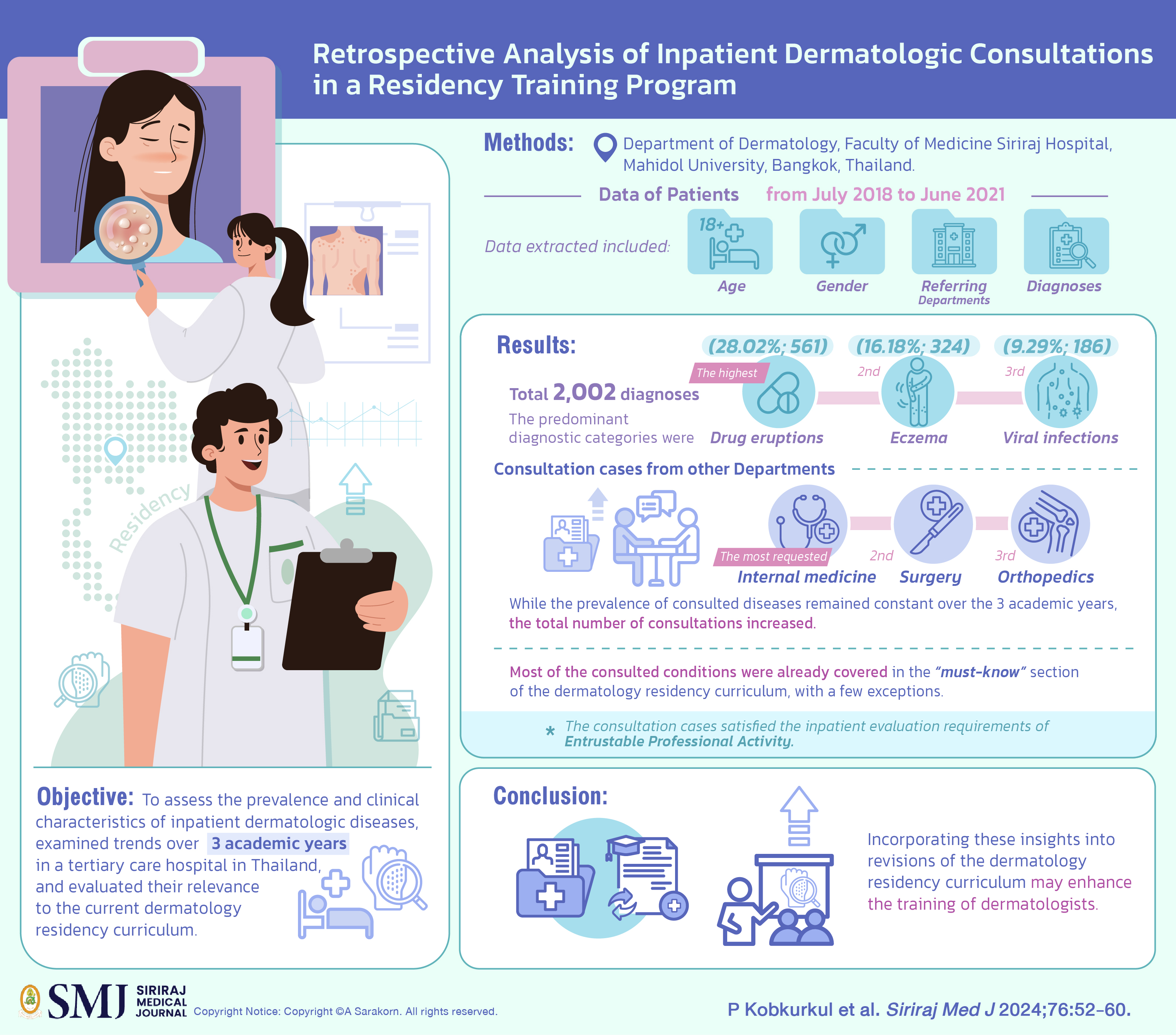Retrospective Analysis of Inpatient Dermatologic Consultations in a Residency Training Program
DOI:
https://doi.org/10.33192/smj.v76i2.266387Keywords:
dermatologic consultation, Dermatology, Inpatient Dermatology, Residency trainingAbstract
Objective: This study assessed the prevalence and clinical characteristics of inpatient dermatologic diseases, examined trends over 3 academic years in a tertiary care hospital in Thailand, and evaluated their relevance to the current dermatology residency curriculum.
Materials and Methods: A retrospective review was performed at the Department of Dermatology, Faculty of Medicine Siriraj Hospital, Mahidol University, Bangkok, Thailand. Consultation records from July 2018 to June 2021 were assessed. Data extracted included patient age, sex, referring departments, and diagnoses.
Results: Of the 1964 consultations, 2002 diagnoses were identified. Consistent with previous findings, the predominant diagnostic categories were drug eruptions (28.02%; 561), eczema (16.18%; 324), and viral infections (9.29%; 186). Internal medicine made the most requests, followed by surgery and orthopedics. While the prevalence of consulted diseases remained constant over the 3 academic years, the total number of consultations increased. Most of the consulted conditions were already covered in the “must-know” section of the dermatology residency curriculum, with a few exceptions. The consultation cases satisfied the inpatient evaluation requirements of Entrustable
Professional Activity.
Conclusion: The prevalence of inpatient dermatologic diseases was highest for drug eruptions, followed by eczema and viral infections. The consistent trend in the prevalence of these consulted diseases underscores the significance of inpatient dermatology. Incorporating these insights into revisions of the dermatology residency curriculum may enhance the training of dermatologists.
References
Mancusi S, Festa Neto C. Inpatient dermatological consultations in a university hospital. Clinics (Sao Paulo). 2010;65(9):851-5.
Noe MH, Rosenbach M. Inpatient Dermatologists-Crucial for the Management of Skin Diseases in Hospitalized Patients. JAMA Dermatol. 2018;154(5):524-5.
Vinay K, Thakur V, Choudhary R, Dev A, Chatterjee D, Handa S. A Retrospective Study to Evaluate the Impact of In-Patient Dermatological Consultations on Diagnostic Accuracy in a Tertiary Care Setting. Indian Dermatol Online J. 2021;12(3):417-22.
Galimberti F, Guren L, Fernandez AP, Sood A. Dermatology consultations significantly contribute quality to care of hospitalized patients: a prospective study of dermatology inpatient consults at a tertiary care center. Int J Dermatol. 2016;55(10):e547-51.
Joseph J, Truong K, Smith A, Fernandez-Penas P. Dermatology inpatient consultations in a tertiary hospital - a retrospective analysis. Int J Dermatol. 2022;61(1):48-53.
Milani-Nejad N, Zhang M, Kaffenberger BH. Association of Dermatology Consultations With Patient Care Outcomes in Hospitalized Patients With Inflammatory Skin Diseases. JAMA Dermatol. 2017;153(6):523-8.
Lorente-Lavirgen AI, Bernabeu-Wittel J, Pulpillo-Ruiz Á, de la Torre-García JM, Conejo-Mir J. Inpatient dermatology consultation in a Spanish tertiary care hospital: a prospective cohort study. Actas Dermosifiliogr. 2013;104(2):148-55.
Fernandes IC, Velho G, Selores M. Dermatology inpatient consultation in a Portuguese university hospital. Dermatol Online J. 2012;18(6):16.
Williams A, Bhatia A, Kanish B, Chaudhary PR, Samuel CJ. Pattern of Inpatient Dermatology Consultations in a Tertiary Care Centre from Northern India. J Clin Diagn Res. 2016;10(12):WC07-WC10.
Balai M, Gupta LK, Khare AK, Mittal A, Mehta S, Bharti G. Pattern of inpatient referrals to dermatology at a tertiary care centre of South Rajasthan. Indian Dermatol Online J. 2017;8(1):25-8.
Peñate Y, Guillermo N, Melwani P, Martel R, Borrego L. Dermatologists in Hospital Wards: An 8-Year Study of Dermatology Consultations. Dermatology. 2009;219(3):225-31.
Dantas LD, Bakos L, Balbinot G, Drechsler CE, Eidt LM. Prevalence of dermatoses in dermatologic evaluation requests from patients admitted to a tertiary hospital for 10 years. An Bras Dermatol. 2015;90(5):762-4.
Fischer M, Bergert H, Marsch WC. Das dermatologische Konsil. Der Hautarzt. 2004;55(6):543-8.
Wamaphutta K, Thasen C, Sereeaphinan C, Chaweekulrat P, Boonchai W. Impact of the COVID-19 Pandemic on Tertiarycare University Dermatology Outpatient Clinic and Dermatology Procedures. Siriraj Med J. 2022;74(12):836-43.
Residency Training in Dermatology, Department of Dermatology, Faculty of Medicine Siriraj Hospital. Department of Dermatology, Faculty of Medicine Siriraj Hospital 2019.
Absolute numbers, incidence and mortality, males and females in Thailand [Internet]. World Health Organization 2023 [cited 2023 July 18]. Available from: https://gco.iarc.fr/overtime/en.
Hammond MI, Sharma TR, Cooper KD, Beveridge MG. Conducting inpatient dermatology consultations and maintaining resident education in the COVID-19 telemedicine era. J Am Acad Dermatol. 2020;83(4):e317-e8.

Published
How to Cite
License
Copyright (c) 2024 Siriraj Medical Journal

This work is licensed under a Creative Commons Attribution-NonCommercial-NoDerivatives 4.0 International License.
Authors who publish with this journal agree to the following conditions:
Copyright Transfer
In submitting a manuscript, the authors acknowledge that the work will become the copyrighted property of Siriraj Medical Journal upon publication.
License
Articles are licensed under a Creative Commons Attribution-NonCommercial-NoDerivatives 4.0 International License (CC BY-NC-ND 4.0). This license allows for the sharing of the work for non-commercial purposes with proper attribution to the authors and the journal. However, it does not permit modifications or the creation of derivative works.
Sharing and Access
Authors are encouraged to share their article on their personal or institutional websites and through other non-commercial platforms. Doing so can increase readership and citations.














